Ruoyu Feng
ContentV: Efficient Training of Video Generation Models with Limited Compute
Jun 05, 2025Abstract:Recent advances in video generation demand increasingly efficient training recipes to mitigate escalating computational costs. In this report, we present ContentV, an 8B-parameter text-to-video model that achieves state-of-the-art performance (85.14 on VBench) after training on 256 x 64GB Neural Processing Units (NPUs) for merely four weeks. ContentV generates diverse, high-quality videos across multiple resolutions and durations from text prompts, enabled by three key innovations: (1) A minimalist architecture that maximizes reuse of pre-trained image generation models for video generation; (2) A systematic multi-stage training strategy leveraging flow matching for enhanced efficiency; and (3) A cost-effective reinforcement learning with human feedback framework that improves generation quality without requiring additional human annotations. All the code and models are available at: https://contentv.github.io.
Rethinking Domain Adaptation and Generalization in the Era of CLIP
Jul 21, 2024



Abstract:In recent studies on domain adaptation, significant emphasis has been placed on the advancement of learning shared knowledge from a source domain to a target domain. Recently, the large vision-language pre-trained model, i.e., CLIP has shown strong ability on zero-shot recognition, and parameter efficient tuning can further improve its performance on specific tasks. This work demonstrates that a simple domain prior boosts CLIP's zero-shot recognition in a specific domain. Besides, CLIP's adaptation relies less on source domain data due to its diverse pre-training dataset. Furthermore, we create a benchmark for zero-shot adaptation and pseudo-labeling based self-training with CLIP. Last but not least, we propose to improve the task generalization ability of CLIP from multiple unlabeled domains, which is a more practical and unique scenario. We believe our findings motivate a rethinking of domain adaptation benchmarks and the associated role of related algorithms in the era of CLIP.
Rate-Distortion-Cognition Controllable Versatile Neural Image Compression
Jul 16, 2024Abstract:Recently, the field of Image Coding for Machines (ICM) has garnered heightened interest and significant advances thanks to the rapid progress of learning-based techniques for image compression and analysis. Previous studies often require training separate codecs to support various bitrate levels, machine tasks, and networks, thus lacking both flexibility and practicality. To address these challenges, we propose a rate-distortion-cognition controllable versatile image compression, which method allows the users to adjust the bitrate (i.e., Rate), image reconstruction quality (i.e., Distortion), and machine task accuracy (i.e., Cognition) with a single neural model, achieving ultra-controllability. Specifically, we first introduce a cognition-oriented loss in the primary compression branch to train a codec for diverse machine tasks. This branch attains variable bitrate by regulating quantization degree through the latent code channels. To further enhance the quality of the reconstructed images, we employ an auxiliary branch to supplement residual information with a scalable bitstream. Ultimately, two branches use a `$\beta x + (1 - \beta) y$' interpolation strategy to achieve a balanced cognition-distortion trade-off. Extensive experiments demonstrate that our method yields satisfactory ICM performance and flexible Rate-Distortion-Cognition controlling.
PromptCIR: Blind Compressed Image Restoration with Prompt Learning
Apr 26, 2024Abstract:Blind Compressed Image Restoration (CIR) has garnered significant attention due to its practical applications. It aims to mitigate compression artifacts caused by unknown quality factors, particularly with JPEG codecs. Existing works on blind CIR often seek assistance from a quality factor prediction network to facilitate their network to restore compressed images. However, the predicted numerical quality factor lacks spatial information, preventing network adaptability toward image contents. Recent studies in prompt-learning-based image restoration have showcased the potential of prompts to generalize across varied degradation types and degrees. This motivated us to design a prompt-learning-based compressed image restoration network, dubbed PromptCIR, which can effectively restore images from various compress levels. Specifically, PromptCIR exploits prompts to encode compression information implicitly, where prompts directly interact with soft weights generated from image features, thus providing dynamic content-aware and distortion-aware guidance for the restoration process. The light-weight prompts enable our method to adapt to different compression levels, while introducing minimal parameter overhead. Overall, PromptCIR leverages the powerful transformer-based backbone with the dynamic prompt module to proficiently handle blind CIR tasks, winning first place in the NTIRE 2024 challenge of blind compressed image enhancement track. Extensive experiments have validated the effectiveness of our proposed PromptCIR. The code is available at https://github.com/lbc12345/PromptCIR-NTIRE24.
SeD: Semantic-Aware Discriminator for Image Super-Resolution
Feb 29, 2024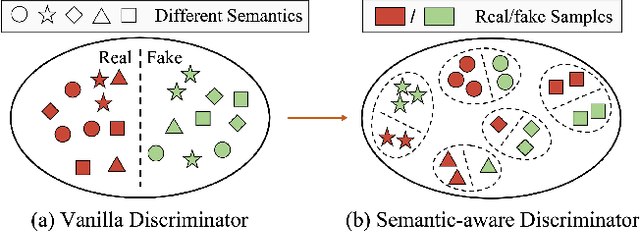
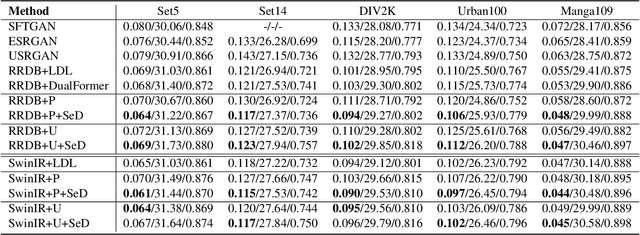
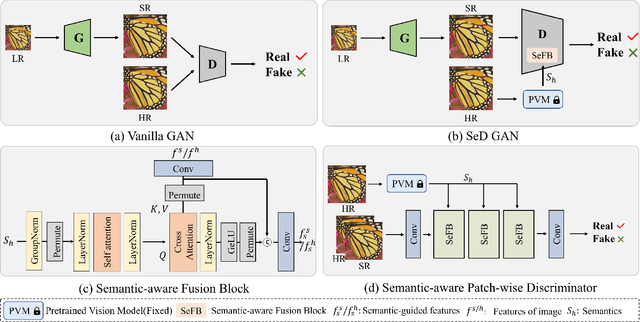
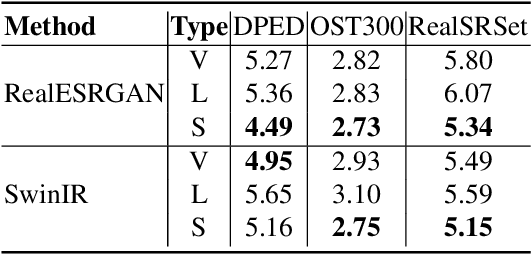
Abstract:Generative Adversarial Networks (GANs) have been widely used to recover vivid textures in image super-resolution (SR) tasks. In particular, one discriminator is utilized to enable the SR network to learn the distribution of real-world high-quality images in an adversarial training manner. However, the distribution learning is overly coarse-grained, which is susceptible to virtual textures and causes counter-intuitive generation results. To mitigate this, we propose the simple and effective Semantic-aware Discriminator (denoted as SeD), which encourages the SR network to learn the fine-grained distributions by introducing the semantics of images as a condition. Concretely, we aim to excavate the semantics of images from a well-trained semantic extractor. Under different semantics, the discriminator is able to distinguish the real-fake images individually and adaptively, which guides the SR network to learn the more fine-grained semantic-aware textures. To obtain accurate and abundant semantics, we take full advantage of recently popular pretrained vision models (PVMs) with extensive datasets, and then incorporate its semantic features into the discriminator through a well-designed spatial cross-attention module. In this way, our proposed semantic-aware discriminator empowered the SR network to produce more photo-realistic and pleasing images. Extensive experiments on two typical tasks, i.e., SR and Real SR have demonstrated the effectiveness of our proposed methods.
ART$\boldsymbol{\cdot}$V: Auto-Regressive Text-to-Video Generation with Diffusion Models
Nov 30, 2023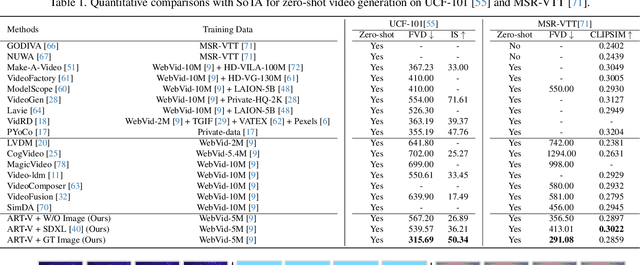
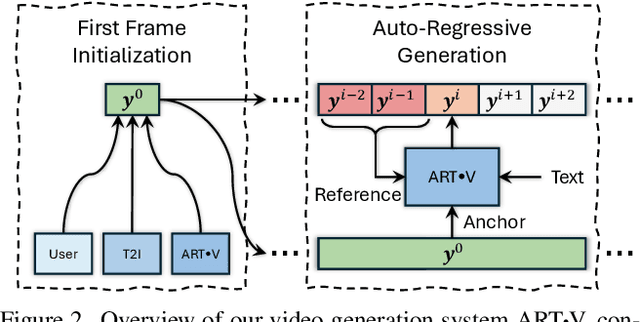
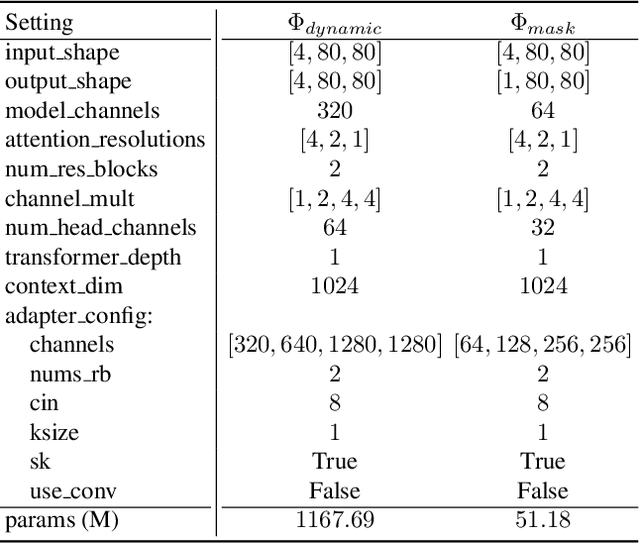
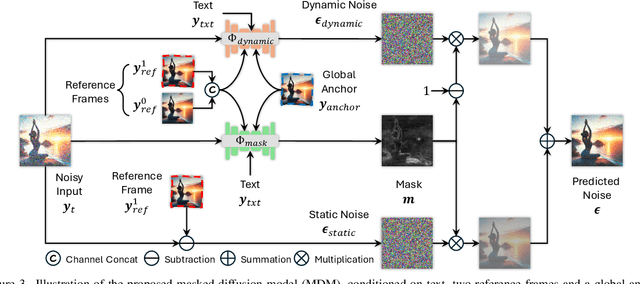
Abstract:We present ART$\boldsymbol{\cdot}$V, an efficient framework for auto-regressive video generation with diffusion models. Unlike existing methods that generate entire videos in one-shot, ART$\boldsymbol{\cdot}$V generates a single frame at a time, conditioned on the previous ones. The framework offers three distinct advantages. First, it only learns simple continual motions between adjacent frames, therefore avoiding modeling complex long-range motions that require huge training data. Second, it preserves the high-fidelity generation ability of the pre-trained image diffusion models by making only minimal network modifications. Third, it can generate arbitrarily long videos conditioned on a variety of prompts such as text, image or their combinations, making it highly versatile and flexible. To combat the common drifting issue in AR models, we propose masked diffusion model which implicitly learns which information can be drawn from reference images rather than network predictions, in order to reduce the risk of generating inconsistent appearances that cause drifting. Moreover, we further enhance generation coherence by conditioning it on the initial frame, which typically contains minimal noise. This is particularly useful for long video generation. When trained for only two weeks on four GPUs, ART$\boldsymbol{\cdot}$V already can generate videos with natural motions, rich details and a high level of aesthetic quality. Besides, it enables various appealing applications, e.g., composing a long video from multiple text prompts.
MicroCinema: A Divide-and-Conquer Approach for Text-to-Video Generation
Nov 30, 2023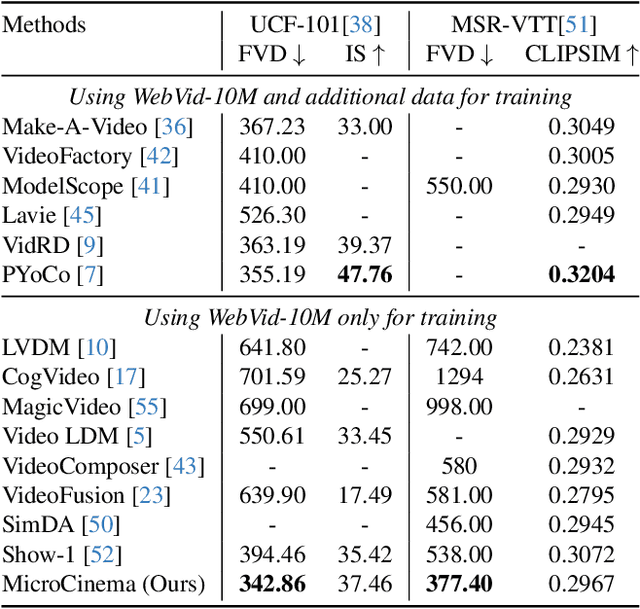
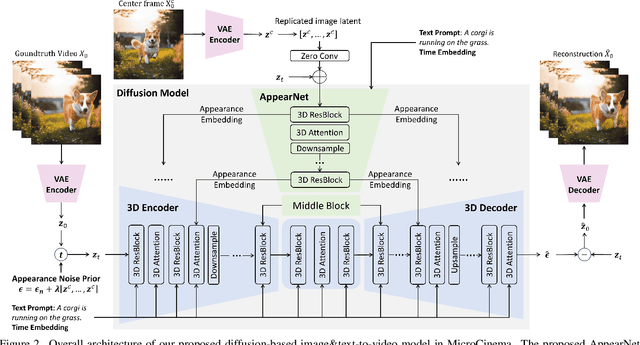
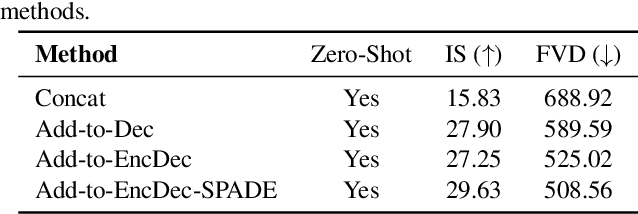
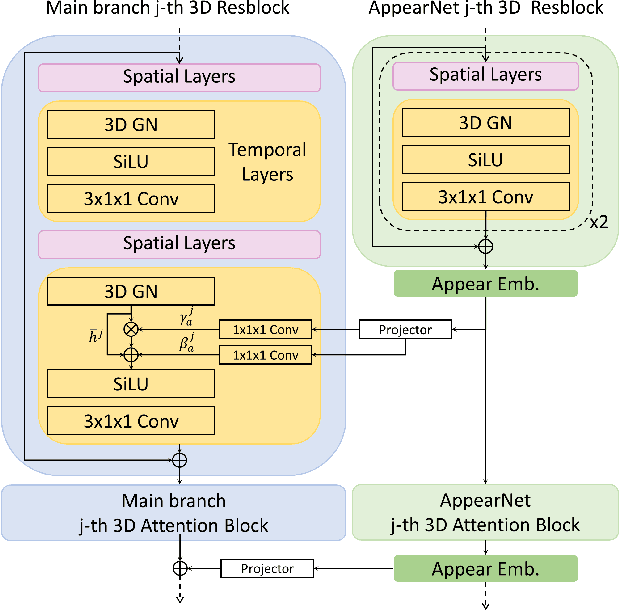
Abstract:We present MicroCinema, a straightforward yet effective framework for high-quality and coherent text-to-video generation. Unlike existing approaches that align text prompts with video directly, MicroCinema introduces a Divide-and-Conquer strategy which divides the text-to-video into a two-stage process: text-to-image generation and image\&text-to-video generation. This strategy offers two significant advantages. a) It allows us to take full advantage of the recent advances in text-to-image models, such as Stable Diffusion, Midjourney, and DALLE, to generate photorealistic and highly detailed images. b) Leveraging the generated image, the model can allocate less focus to fine-grained appearance details, prioritizing the efficient learning of motion dynamics. To implement this strategy effectively, we introduce two core designs. First, we propose the Appearance Injection Network, enhancing the preservation of the appearance of the given image. Second, we introduce the Appearance Noise Prior, a novel mechanism aimed at maintaining the capabilities of pre-trained 2D diffusion models. These design elements empower MicroCinema to generate high-quality videos with precise motion, guided by the provided text prompts. Extensive experiments demonstrate the superiority of the proposed framework. Concretely, MicroCinema achieves SOTA zero-shot FVD of 342.86 on UCF-101 and 377.40 on MSR-VTT. See https://wangyanhui666.github.io/MicroCinema.github.io/ for video samples.
CCEdit: Creative and Controllable Video Editing via Diffusion Models
Sep 28, 2023



Abstract:In this work, we present CCEdit, a versatile framework designed to address the challenges of creative and controllable video editing. CCEdit accommodates a wide spectrum of user editing requirements and enables enhanced creative control through an innovative approach that decouples video structure and appearance. We leverage the foundational ControlNet architecture to preserve structural integrity, while seamlessly integrating adaptable temporal modules compatible with state-of-the-art personalization techniques for text-to-image generation, such as DreamBooth and LoRA.Furthermore, we introduce reference-conditioned video editing, empowering users to exercise precise creative control over video editing through the more manageable process of editing key frames. Our extensive experimental evaluations confirm the exceptional functionality and editing capabilities of the proposed CCEdit framework. Demo video is available at https://www.youtube.com/watch?v=UQw4jq-igN4.
Semantically Structured Image Compression via Irregular Group-Based Decoupling
May 04, 2023



Abstract:Image compression techniques typically focus on compressing rectangular images for human consumption, however, resulting in transmitting redundant content for downstream applications. To overcome this limitation, some previous works propose to semantically structure the bitstream, which can meet specific application requirements by selective transmission and reconstruction. Nevertheless, they divide the input image into multiple rectangular regions according to semantics and ignore avoiding information interaction among them, causing waste of bitrate and distorted reconstruction of region boundaries. In this paper, we propose to decouple an image into multiple groups with irregular shapes based on a customized group mask and compress them independently. Our group mask describes the image at a finer granularity, enabling significant bitrate saving by reducing the transmission of redundant content. Moreover, to ensure the fidelity of selective reconstruction, this paper proposes the concept of group-independent transform that maintain the independence among distinct groups. And we instantiate it by the proposed Group-Independent Swin-Block (GI Swin-Block). Experimental results demonstrate that our framework structures the bitstream with negligible cost, and exhibits superior performance on both visual quality and intelligent task supporting.
Prompt-ICM: A Unified Framework towards Image Coding for Machines with Task-driven Prompts
May 04, 2023Abstract:Image coding for machines (ICM) aims to compress images to support downstream AI analysis instead of human perception. For ICM, developing a unified codec to reduce information redundancy while empowering the compressed features to support various vision tasks is very important, which inevitably faces two core challenges: 1) How should the compression strategy be adjusted based on the downstream tasks? 2) How to well adapt the compressed features to different downstream tasks? Inspired by recent advances in transferring large-scale pre-trained models to downstream tasks via prompting, in this work, we explore a new ICM framework, termed Prompt-ICM. To address both challenges by carefully learning task-driven prompts to coordinate well the compression process and downstream analysis. Specifically, our method is composed of two core designs: a) compression prompts, which are implemented as importance maps predicted by an information selector, and used to achieve different content-weighted bit allocations during compression according to different downstream tasks; b) task-adaptive prompts, which are instantiated as a few learnable parameters specifically for tuning compressed features for the specific intelligent task. Extensive experiments demonstrate that with a single feature codec and a few extra parameters, our proposed framework could efficiently support different kinds of intelligent tasks with much higher coding efficiency.
 Add to Chrome
Add to Chrome Add to Firefox
Add to Firefox Add to Edge
Add to Edge